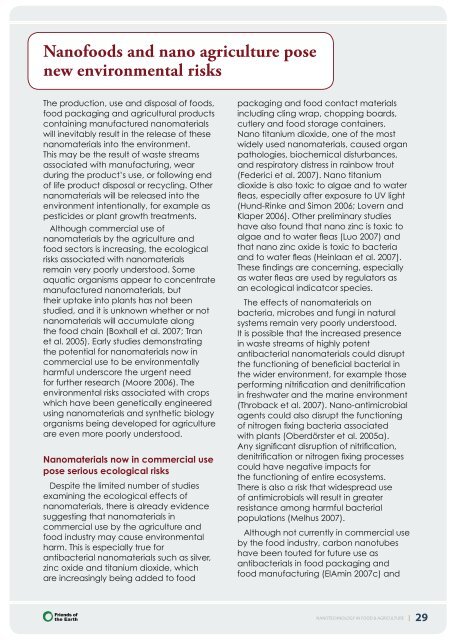Nanotechnology in Food & Agriculture - denix
Nanotechnology in Food & Agriculture - denix
Nanotechnology in Food & Agriculture - denix
You also want an ePaper? Increase the reach of your titles
YUMPU automatically turns print PDFs into web optimized ePapers that Google loves.
Nanofoods and nano agriculture pose<br />
new environmental risks<br />
The production, use and disposal of foods,<br />
food packag<strong>in</strong>g and agricultural products<br />
conta<strong>in</strong><strong>in</strong>g manufactured nanomaterials<br />
will <strong>in</strong>evitably result <strong>in</strong> the release of these<br />
nanomaterials <strong>in</strong>to the environment.<br />
This may be the result of waste streams<br />
associated with manufactur<strong>in</strong>g, wear<br />
dur<strong>in</strong>g the product’s use, or follow<strong>in</strong>g end<br />
of life product disposal or recycl<strong>in</strong>g. Other<br />
nanomaterials will be released <strong>in</strong>to the<br />
environment <strong>in</strong>tentionally, for example as<br />
pesticides or plant growth treatments.<br />
Although commercial use of<br />
nanomaterials by the agriculture and<br />
food sectors is <strong>in</strong>creas<strong>in</strong>g, the ecological<br />
risks associated with nanomaterials<br />
rema<strong>in</strong> very poorly understood. Some<br />
aquatic organisms appear to concentrate<br />
manufactured nanomaterials, but<br />
their uptake <strong>in</strong>to plants has not been<br />
studied, and it is unknown whether or not<br />
nanomaterials will accumulate along<br />
the food cha<strong>in</strong> (Boxhall et al. 2007; Tran<br />
et al. 2005). Early studies demonstrat<strong>in</strong>g<br />
the potential for nanomaterials now <strong>in</strong><br />
commercial use to be environmentally<br />
harmful underscore the urgent need<br />
for further research (Moore 2006). The<br />
environmental risks associated with crops<br />
which have been genetically eng<strong>in</strong>eered<br />
us<strong>in</strong>g nanomaterials and synthetic biology<br />
organisms be<strong>in</strong>g developed for agriculture<br />
are even more poorly understood.<br />
Nanomaterials now <strong>in</strong> commercial use<br />
pose serious ecological risks<br />
Despite the limited number of studies<br />
exam<strong>in</strong><strong>in</strong>g the ecological effects of<br />
nanomaterials, there is already evidence<br />
suggest<strong>in</strong>g that nanomaterials <strong>in</strong><br />
commercial use by the agriculture and<br />
food <strong>in</strong>dustry may cause environmental<br />
harm. This is especially true for<br />
antibacterial nanomaterials such as silver,<br />
z<strong>in</strong>c oxide and titanium dioxide, which<br />
are <strong>in</strong>creas<strong>in</strong>gly be<strong>in</strong>g added to food<br />
Friends of<br />
the Earth<br />
packag<strong>in</strong>g and food contact materials<br />
<strong>in</strong>clud<strong>in</strong>g cl<strong>in</strong>g wrap, chopp<strong>in</strong>g boards,<br />
cutlery and food storage conta<strong>in</strong>ers.<br />
Nano titanium dioxide, one of the most<br />
widely used nanomaterials, caused organ<br />
pathologies, biochemical disturbances,<br />
and respiratory distress <strong>in</strong> ra<strong>in</strong>bow trout<br />
(Federici et al. 2007). Nano titanium<br />
dioxide is also toxic to algae and to water<br />
fleas, especially after exposure to UV light<br />
(Hund-R<strong>in</strong>ke and Simon 2006; Lovern and<br />
Klaper 2006). Other prelim<strong>in</strong>ary studies<br />
have also found that nano z<strong>in</strong>c is toxic to<br />
algae and to water fleas (Luo 2007) and<br />
that nano z<strong>in</strong>c oxide is toxic to bacteria<br />
and to water fleas (He<strong>in</strong>laan et al. 2007).<br />
These f<strong>in</strong>d<strong>in</strong>gs are concern<strong>in</strong>g, especially<br />
as water fleas are used by regulators as<br />
an ecological <strong>in</strong>dicatcor species.<br />
The effects of nanomaterials on<br />
bacteria, microbes and fungi <strong>in</strong> natural<br />
systems rema<strong>in</strong> very poorly understood.<br />
It is possible that the <strong>in</strong>creased presence<br />
<strong>in</strong> waste streams of highly potent<br />
antibacterial nanomaterials could disrupt<br />
the function<strong>in</strong>g of beneficial bacterial <strong>in</strong><br />
the wider environment, for example those<br />
perform<strong>in</strong>g nitrification and denitrification<br />
<strong>in</strong> freshwater and the mar<strong>in</strong>e environment<br />
(Throback et al. 2007). Nano-antimicrobial<br />
agents could also disrupt the function<strong>in</strong>g<br />
of nitrogen fix<strong>in</strong>g bacteria associated<br />
with plants (Oberdörster et al. 2005a).<br />
Any significant disruption of nitrification,<br />
denitrification or nitrogen fix<strong>in</strong>g processes<br />
could have negative impacts for<br />
the function<strong>in</strong>g of entire ecosystems.<br />
There is also a risk that widespread use<br />
of antimicrobials will result <strong>in</strong> greater<br />
resistance among harmful bacterial<br />
populations (Melhus 2007).<br />
Although not currently <strong>in</strong> commercial use<br />
by the food <strong>in</strong>dustry, carbon nanotubes<br />
have been touted for future use as<br />
antibacterials <strong>in</strong> food packag<strong>in</strong>g and<br />
food manufactur<strong>in</strong>g (ElAm<strong>in</strong> 2007c) and<br />
NANOTECHNOLOGY IN FOOD & AGRICULTURE | 29
















